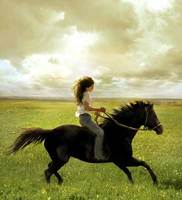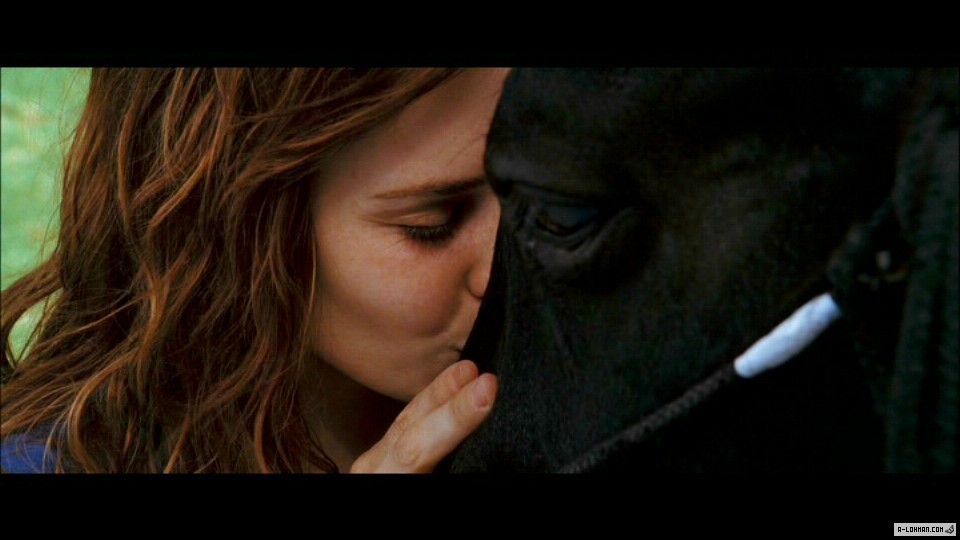
Flicka is a film partially based on the novel My Friend Flicka by Mary O’Hara written in the 1940’s. This movie however, is set in the 21st century and the main character is not a boy, but a girl by the name of Katherine “Katy” McLaughlin. This gender change from book to movie could be due to the commonality of females and horses together in the recent century, especially in the film industry. Before this time however, horses were rarely combined with females in stories,. Equestrian events today are seen as “girly” and “cast alongside chick flicks and other programming typecast as “women’s interest’”.1 When one thinks to other equestrian movies like Dreamer, Black Beauty, The Black Stallion or All The Pretty Horses, most think about young, teenage girls and their horses. This could be due to the fact that most of these movies, with the exception, perhaps, of horse racing, have the main protagonist as a female, whether teenage or older.
Katy lives on a horse ranch in Wyoming owned by her family, with a wish to one day run the family ranch. Her father, Rob, disagrees with her decision and her “wild” spirit, believing that her brother should run the ranch and instead believes that she should go to college, so he sends her to a private school. Katy finds she does not fit in at the school, simply wishing to be home at the horse ranch and riding, rather than be around teenagers at school. Once returning from school, where she has failed to complete an important assignment, Katy goes riding and finds a wild mustang. She feels a connection with the mare; both are wild and spirited. The girl attempts to tame the mustang, though her father does not want her to keep the wild mustang near the horses on their ranch. Despite Rob’s belief that Flicka is too wild and “untamable”, Flicka begins to warm to Katy, but her father finds out and sells her. This decision starts to tear the family apart due to Rob’s decision to sell Flicka, and Howard, Katy’s brother, furiously refuses to run the family ranch. This causes Rob to decide to sell the farm in return.

Katy’s connection to Flicka causes her to attempt to take Flicka back with the help of her brother at a competition, but her father sees them. Katy rides off with Flicka to escape and quickly get lost in the forest. A mountain lion finds them and attacks Flicka, who throws Katy to the ground and leaves the mountain lion to advance on her. Flicka returns and fights for a defenseless Katy, but becomes very injured. Katy does her best to cover Flicka’s wounds, but develops a fever in the storm that ensues. Rob finds the pair in the forest and carries Katy back to their ranch, where he decides that Flicka is mortally injured and should be put down. Katy overhears her father’s thoughts to put Flicka down and tells him that “it’sokay, you can shoot us.” Shockingly, Katy refers to Flicka as “us”, as if their similar spirits and experiences have made them truly one person. Rob rushes outside, as he finally understands what Flicka means to his daughter, that the mustang is a part of her now. The next day, Rob finds the injured mustang and amazed that she is still alive, returns with her to the ranch. Katy starts to get better and recover, and when she wakes, she is befuddled that Flicka is at the ranch, alive. The family reconciles and decides, as a family, not to sell the ranch. In the end, the wild, spirited animal that started to tear the family apart, brought them closer than ever and put each family member in the positions that they were meant to be in.
The normal disclaimer of “No animals were harmed in the making of this movie” was not possible in the credits or opening of this movie, as two horses accidently died in the filming of this movie. “One horse fractured his tibia during a well-rehearsed running scene in Simi Valley, Calif., and the other horse tripped on a lead rope and broke its neck after a fall.”2 The deaths were investigated and were both ruled accidents by Certified Animal Safety Representatives. The representatives stated that these accidents and others like them are unfortunate, but unpreventable and they will remain monitoring film-animals’ treatment. While I believe that this is true, I cannot help but wonder if it is enough, if this use of animals in film should be continued. Jonathan Burt discusses film-animal use 3, saying that the problem of the use of animals in films has been worsening over the years. In addition, the problem is also in the regulation of these film animals perhaps due to increasing numbers of these uses of animals in film, or not enough regulation itself. The problem does not seem to be in the treatment of animals for the most part; they are not starving to death or dying from heat-stroke, but instead they are dying from accidents while filming these scenes. These animals, horses in this instance, are suffering from accidents when the scenes are being shot, for example the alleged near drowning during filming of the tiger character from the movie, “Life of Pi”.
Bibliography:
1- McHugh, Susan. Animal Stories: Narrating Across Species Lines. (Minneapolis, MN, USA: University of Minnesota Press, 2011).
2- Nonawitz, Amy. CBS. Horses Died on the Set of ‘Flicka’. https://www.cbsnews.com/news/horses-died-on-set-of-flicka/
3- Burt, Jonathan. Animals in Film. (London, UK: Reaktion Books, 2002).